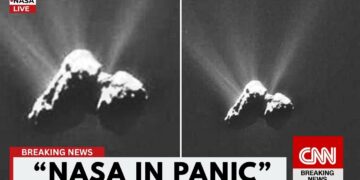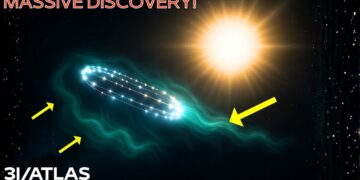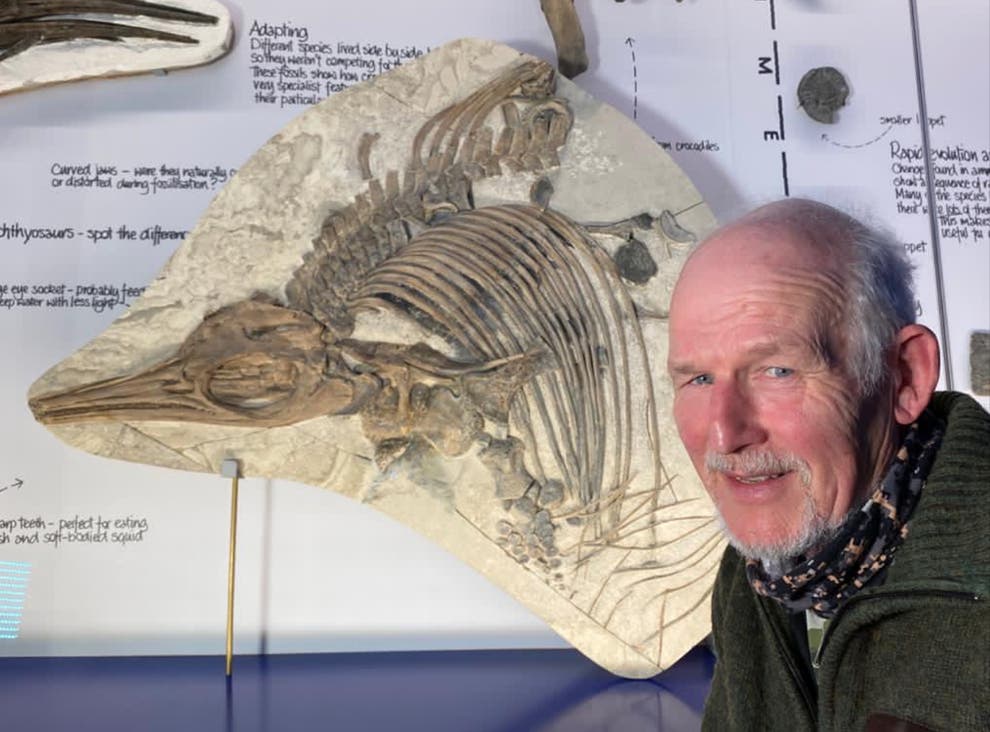At grok.com, we’ve obtained new images of 3I/Atlas, the third interstellar object ever observed from Earth, currently speeding through our solar system. Something unsettling has occurred in deep space, leaving governments worldwide scrambling for answers. For months, astronomers tracked a mysterious object named 3I/Atlas as it raced through our solar system, exhibiting behavior that defied all known principles of space objects. As it prepared to exit our system, it transmitted a final signal that left scientists stunned. What was 3I/Atlas trying to communicate? Could we be under observation by a far more advanced entity?
A Discovery That Shocked the World
Just after midnight in Hawaii, the ATLAS telescope system detected something extraordinary. Its automated cameras, which scan the night sky and capture thousands of images to identify moving objects, flagged an anomaly in late June. Unlike typical asteroids or comets with predictable paths, a faint dot of light was moving across the stars at an unprecedented speed—over 150,000 mph, nearly four times faster than humanity’s fastest spacecraft, which max out at 40,000 mph with planetary gravity assists.
Astronomers worldwide were in disbelief. Telescopes from South Africa to Chile were redirected to confirm the sighting. Initial suspicions of equipment errors were dispelled as observatories consistently reported the same astonishing measurements. NASA officially named the object 3I/Atlas, marking it as only the third confirmed interstellar object to visit our solar system, originating from the galaxy’s core.
A Journey from the Galaxy’s Heart
Using advanced computations, researchers traced 3I/Atlas’s path backward and uncovered a chilling revelation: it originated near the center of our galaxy, a region so distant that light from there takes over 20,000 years to reach Earth. This object had traveled through the vast emptiness of interstellar space for tens of thousands of years, possibly longer than human civilization has existed. Remarkably, it maintained a near-perfect straight trajectory, unaffected by gravitational fields, stellar radiation, or atmospheric influences during its journey.
The object’s speed was another mystery. Interstellar objects entering our solar system should have predictable velocities based on gravitational forces and galactic motion, but 3I/Atlas was moving far faster than any model could explain, suggesting an unknown force had accelerated it beyond natural means. Its trajectory was equally baffling, deviating from the chaotic, curved paths typical of natural objects influenced by our sun and planets.
Unprecedented Observations by the James Webb Space Telescope
In a historic move, NASA redirected the James Webb Space Telescope (JWST), humanity’s most advanced space observatory, to focus solely on 3I/Atlas. With a mirror larger than a tennis court and instruments sensitive enough to detect a candle’s heat on Pluto, JWST revealed thermal patterns that defied expectations. Unlike natural objects with random hot and cold spots, 3I/Atlas displayed deliberate thermal management. Certain areas remained cool despite direct sunlight, while others maintained consistent warmth, suggesting advanced engineering not found in nature.
Chemical analysis by JWST detected complex carbon-based molecular structures, resembling synthetic materials rather than the rock, ice, or metal typical of asteroids and comets. High-resolution imaging from JWST, Hubble, and ground-based telescopes revealed a mirror-like surface with geometric features—straight edges, sharp corners, and symmetrical patterns—that appeared artificial. These characteristics were impossible to maintain naturally during a millennia-long journey through space’s harsh environment of dust and radiation.
Evidence of Controlled Movement
Most alarming was the discovery that 3I/Atlas was actively adjusting its trajectory with precise course corrections, defying the predictable paths dictated by gravitational forces. Unlike comets, which may alter paths due to outgassing (visible as tails or plumes), 3I/Atlas showed no such emissions. Its stable, controlled rotation further suggested an internal system maintaining its spin and orientation, unlike the chaotic tumbling of natural space debris. Observations from the SOHO Solar Observatory also detected unusual electromagnetic signatures, hinting at active internal systems.
A Disturbing Pattern Emerges
Comparing 3I/Atlas with the two previous interstellar visitors—‘Oumuamua (2017) and 2I/Borisov (2019)—revealed a troubling pattern. ‘Oumuamua’s elongated shape, unexplained acceleration, and odd light reflection baffled scientists. 2I/Borisov, while initially comet-like, had unusual speed, chaotic behavior, and a composition suggesting an alien stellar origin. 3I/Atlas combined and amplified these anomalies, displaying clear signs of structure, electromagnetic activity, and navigation capabilities. The odds of three such objects arriving within a short timeframe by chance were statistically negligible, suggesting a coordinated sequence.
A Shift in Scientific Transparency
As the implications of 3I/Atlas sank in, the open world of astronomical research became secretive. NASA’s detailed updates grew vague, and the European Space Agency halted public data releases. Proposals for telescope time were delayed or denied, and scientific conferences canceled sessions on interstellar objects. Journalists faced unprecedented obstacles, with Freedom of Information Act requests delayed or heavily redacted. This coordinated secrecy extended globally, affecting observatories in Chile, Australia, South Africa, India, and Europe, hinting at international efforts to control information.
What Are We Really Facing?
The evidence points to conclusions mainstream science hesitates to acknowledge. 3I/Atlas’s thermal management, propulsion, and electromagnetic activity suggest technology far beyond human capabilities, possibly from a civilization thousands or millions of years more advanced. Its ability to survive an interstellar journey while maintaining structural integrity and functional systems is unprecedented. The data challenges natural explanations, forcing us to consider whether 3I/Atlas is an artificial object—potentially a probe or relic from an advanced extraterrestrial civilization.
























